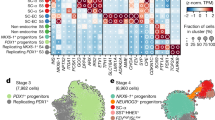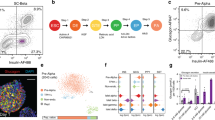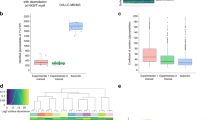Abstract
Using a flow cytometry–based screen of commercial antibodies, we have identified cell-surface markers for the separation of pancreatic cell types derived from human embryonic stem (hES) cells. We show enrichment of pancreatic endoderm cells using CD142 and of endocrine cells using CD200 and CD318. After transplantation into mice, enriched pancreatic endoderm cells give rise to all the pancreatic lineages, including functional insulin-producing cells, demonstrating that they are pancreatic progenitors. In contrast, implanted, enriched polyhormonal endocrine cells principally give rise to glucagon cells. These antibodies will aid investigations that use pancreatic cells generated from pluripotent stem cells to study diabetes and pancreas biology.
This is a preview of subscription content, access via your institution
Access options
Subscribe to this journal
Receive 12 print issues and online access
$209.00 per year
only $17.42 per issue
Buy this article
- Purchase on Springer Link
- Instant access to full article PDF
Prices may be subject to local taxes which are calculated during checkout





Similar content being viewed by others
References
Guo, T. & Hebrok, M. Stem cells to pancreatic beta-cells: new sources for diabetes cell therapy. Endocr. Rev. 30, 214–227 (2009).
Van Hoof, D., D'Amour, K.A. & German, M.S. Derivation of insulin-producing cells from human embryonic stem cells. Stem Cell Res. (Amst.) 3, 73–87 (2009).
D'Amour, K.A. et al. Production of pancreatic hormone-expressing endocrine cells from human embryonic stem cells. Nat. Biotechnol. 24, 1392–1401 (2006).
Kroon, E. et al. Pancreatic endoderm derived from human embryonic stem cells generates glucose-responsive insulin-secreting cells in vivo. Nat. Biotechnol. 26, 443–452 (2008).
Sugiyama, T. & Kim, S.K. Fluorescence-activated cell sorting purification of pancreatic progenitor cells. Diabetes Obes. Metab. 10 (suppl. 4), 179–185 (2008).
McKnight, K.D., Wang, P. & Kim, S.K. Deconstructing pancreas development to reconstruct human islets from pluripotent stem cells. Cell Stem Cell 6, 300–308 (2010).
Winkler, H. & Fischer-Colbrie, R. The chromogranins A and B: the first 25 years and future perspectives. Neuroscience 49, 497–528 (1992).
Pan, F.C. & Wright, C. Pancreas organogenesis: from bud to plexus to gland. Dev. Dyn. 240, 530–565 (2011).
Murray, H.E., Paget, M.B. & Downing, R. Preservation of glucose responsiveness in human islets maintained in a rotational cell culture system. Mol. Cell. Endocrinol. 238, 39–49 (2005).
Gao, R., Ustinov, J., Korsgren, O. & Otonkoski, T. In vitro neogenesis of human islets reflects the plasticity of differentiated human pancreatic cells. Diabetologia 48, 2296–2304 (2005).
Watanabe, K. et al. A ROCK inhibitor permits survival of dissociated human embryonic stem cells. Nat. Biotechnol. 25, 681–686 (2007).
Miyazawa, Y. et al. CUB domain-containing protein 1, a prognostic factor for human pancreatic cancers, promotes cell migration and extracellular matrix degradation. Cancer Res. 70, 5136–5146 (2010).
Uhlen, M. et al. Towards a knowledge-based Human Protein Atlas. Nat. Biotechnol. 28, 1248–1250 (2010).
Luther, T. et al. Tissue factor expression during human and mouse development. Am. J. Pathol. 149, 101–113 (1996).
Moberg, L. et al. Production of tissue factor by pancreatic islet cells as a trigger of detrimental thrombotic reactions in clinical islet transplantation. Lancet 360, 2039–2045 (2002).
Beuneu, C. et al. Human pancreatic duct cells exert tissue factor-dependent procoagulant activity: relevance to islet transplantation. Diabetes 53, 1407–1411 (2004).
Gu, G., Dubauskaite, J. & Melton, D.A. Direct evidence for the pancreatic lineage: NGN3+ cells are islet progenitors and are distinct from duct progenitors. Development 129, 2447–2457 (2002).
Kawaguchi, Y. et al. The role of the transcriptional regulator Ptf1a in converting intestinal to pancreatic progenitors. Nat. Genet. 32, 128–134 (2002).
Teitelman, G., Alpert, S., Polak, J.M., Martinez, A. & Hanahan, D. Precursor cells of mouse endocrine pancreas coexpress insulin, glucagon and the neuronal proteins tyrosine hydroxylase and neuropeptide Y, but not pancreatic polypeptide. Development 118, 1031–1039 (1993).
Herrera, P.L. Adult insulin- and glucagon-producing cells differentiate from two independent cell lineages. Development 127, 2317–2322 (2000).
Wilson, M.E., Kalamaras, J.A. & German, M.S. Expression pattern of IAPP and prohormone convertase 1/3 reveals a distinctive set of endocrine cells in the embryonic pancreas. Mech. Dev. 115, 171–176 (2002).
Rezania, A. et al. Production of functional glucagon-secreting alpha cells from human embryonic stem cells. Diabetes 60, 239–247 (2011).
Collombat, P. et al. The ectopic expression of Pax4 in the mouse pancreas converts progenitor cells into alpha and subsequently beta cells. Cell 138, 449–462 (2009).
Thorel, F. et al. Conversion of adult pancreatic alpha-cells to beta-cells after extreme beta-cell loss. Nature 464, 1149–1154 (2010).
Chung, C.H., Hao, E., Piran, R., Keinan, E. & Levine, F. Pancreatic beta-cell neogenesis by direct conversion from mature alpha-cells. Stem Cells 28, 1630–1638 (2010).
Hald, J. et al. Generation and characterization of Ptf1a antiserum and localization of Ptf1a in relation to Nkx6.1 and Pdx1 during the earliest stages of mouse pancreas development. J. Histochem. Cytochem. 56, 587–595 (2008).
Braam, S.R., Nauw, R., Ward-van Oostwaard, D., Mummery, C. & Passier, R. Inhibition of ROCK improves survival of human embryonic stem cell-derived cardiomyocytes after dissociation. Ann. NY Acad. Sci. 1188, 52–57 (2010).
Koyanagi, M. et al. Inhibition of the Rho/ROCK pathway reduces apoptosis during transplantation of embryonic stem cell-derived neural precursors. J. Neurosci. Res. 86, 270–280 (2008).
Krawetz, R.J., Li, X. & Rancourt, D.E. Human embryonic stem cells: caught between a ROCK inhibitor and a hard place. Bioessays 31, 336–343 (2009).
Jiang, W. et al. CD24: a novel surface marker for PDX1-positive pancreatic progenitors derived from human embryonic stem cells. Stem Cells 29, 609–617 (2011).
Dorrell, C. et al. Isolation of major pancreatic cell types and long-term culture-initiating cells using novel human surface markers. Stem Cell Res. (Amst.) 1, 183–194 (2008).
Sugiyama, T., Rodriguez, R.T., McLean, G.W. & Kim, S.K. Conserved markers of fetal pancreatic epithelium permit prospective isolation of islet progenitor cells by FACS. Proc. Natl. Acad. Sci. USA 104, 175–180 (2007).
Hori, Y., Fukumoto, M. & Kuroda, Y. Enrichment of putative pancreatic progenitor cells from mice by sorting for prominin1 (CD133) and platelet-derived growth factor receptor beta. Stem Cells 26, 2912–2920 (2008).
Nostro, M.C. et al. Stage-specific signaling through TGFbeta family members and WNT regulates patterning and pancreatic specification of human pluripotent stem cells. Development 138, 861–871 (2011).
Acknowledgements
We thank O. Madsen (Hagedorn Research Institute), C. Wright (Vanderbilt University), J. Johnson (UT Southwestern Medical Center) and BD Biosciences for providing antibodies and A. Elefanty and E. Stanley (Monash University) for providing the MEL1 hES cell line. The CyT203 and CyT49 hES cell lines were derived with partial funding from the Juvenile Diabetes Research Foundation.
Author information
Authors and Affiliations
Contributions
O.G.K. and A.G.B. wrote the paper. O.G.K. and A.G.B. designed, directed and interpreted experiments with intellectual contributions from E.E.B., M.M., L.A.M., E.K., K.A.D., K.K. and M.K.C. The antibody screen was proposed by A.G.B. and carried out by O.G.K., M.Y.C. and M.M. K.A.D. suggested the Y-27632 compound. M.M. developed and performed the flow cytometry assays and analyses with assistance from M.Y.C. and K.G.R. O.G.K., A.G.B., M.Y.C. and T.M.O. performed the cell culture experiments and immuno-magnetic cell separations. M.Y.C. and O.G.K. performed qPCR and immunofluorescence analyses of in vitro material. L.A.M., E.K. and M.R. executed the in vivo experiments, including transplantations and C-peptide assays. K.K. performed the histological and immunofluorescence analyses of implanted grafts.
Corresponding author
Ethics declarations
Competing interests
The authors are employees or former employees of ViaCyte (formerly Novocell).
Supplementary information
Supplementary Text and Figures
Supplementary Table 1 and Supplementary Figures 1–9 (PDF 2938 kb)
Rights and permissions
About this article
Cite this article
Kelly, O., Chan, M., Martinson, L. et al. Cell-surface markers for the isolation of pancreatic cell types derived from human embryonic stem cells. Nat Biotechnol 29, 750–756 (2011). https://doi.org/10.1038/nbt.1931
Received:
Accepted:
Published:
Issue Date:
DOI: https://doi.org/10.1038/nbt.1931
This article is cited by
-
Single-cell transcriptome analysis of NEUROG3+ cells during pancreatic endocrine differentiation with small molecules
Stem Cell Research & Therapy (2023)
-
Development of synthetic modulator enabling long-term propagation and neurogenesis of human embryonic stem cell-derived neural progenitor cells
Biological Research (2023)
-
Pancreatic β-cell heterogeneity in adult human islets and stem cell-derived islets
Cellular and Molecular Life Sciences (2023)
-
A critical review on therapeutic approaches of CRISPR-Cas9 in diabetes mellitus
Naunyn-Schmiedeberg's Archives of Pharmacology (2023)
-
Stepwise differentiation of functional pancreatic β cells from human pluripotent stem cells
Cell Regeneration (2022)



